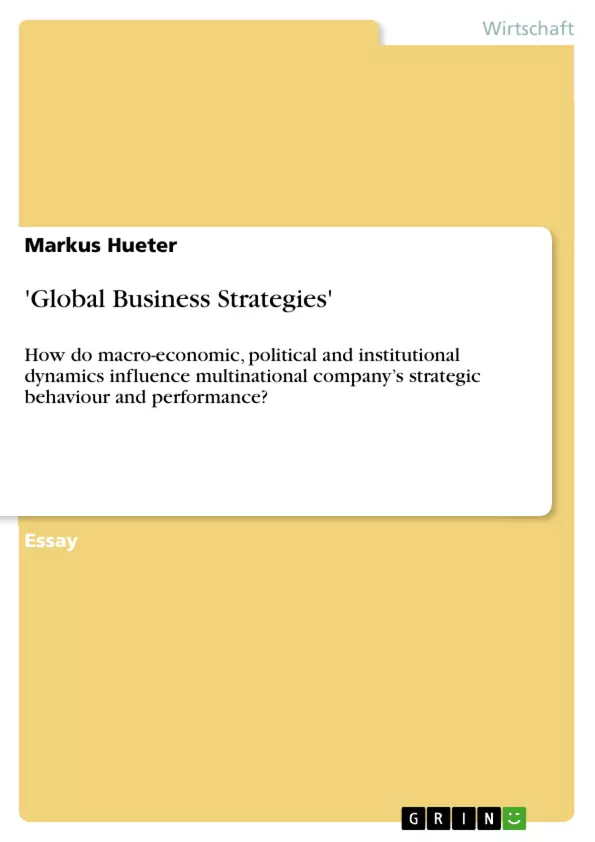Executive Summary
This essay sets out to discuss the environment in which multinational
companies such as Qantas are operating and what control strategies can be applied to monitor and manage their activities to leverage
their competitive advantage across the airline industry.
Introduction
The Qantas Group's principal activities are operating international and domestic air transportation services for leisure and business
travelling, freight and logistics services as well as associated
support activities including information technology, catering, ground
handling, engineering and maintenance (www.qantas.com.au).
Qantas with its dual strategy brand Jetstar flies now to more than 173 destinations in 42 countries and operates a fleet of 246 aircraft.
The airline will operate a 20-strong Airbus 380 fleet by 2015.
The groupis also part of the Oneworld global marketing and code-sharing alliance, which consists of 11 leading Airlines.
Qantas’ stakeholders are its shareholders, employees, customers, business partners and the community.
Indirect stakeholders include the media, governments and non-governmental organisations.
They all have a major influence on the business, its strategy and therefore its performance.
It is to mention that the Qantas Group is in the unique position
of having two outstanding and well established brands in both the premium and low fares categories with Qantas and Jetstar, consisting of the subsidiary brands Jetstar Asia being the largest low fare, “no
frills” Airline in the Asia Pacific Rim, based and operating from Singapore. The Qantas group holds 49 percent of the Jetstar Asia shares. Jetstar Pacific is Vietnam’s first low cost carrier operating
since 2008. The Qantas group holds today a 30 percent stake through foreign direct investment.
Inhaltsverzeichnis
- Executive Summary
- Introduction
- Macro Economic Challenges
- P.E.S.T.-Analysis
- Balanced Scorecard
- Porters Five Forces
- Drivers for Globalization
- Conclusion
- References
Zielsetzung und Themenschwerpunkte
Dieser Essay untersucht das Umfeld, in dem multinationale Unternehmen wie Qantas operieren, und analysiert, welche Kontrollstrategien eingesetzt werden können, um ihre Aktivitäten zu überwachen und zu steuern, um ihren Wettbewerbsvorteil in der Luftfahrtindustrie zu nutzen.
- Analyse des Makroumfelds, in dem Qantas operiert
- Bewertung der Auswirkungen von makroökonomischen, politischen und institutionellen Faktoren auf das strategische Verhalten von multinationalen Unternehmen
- Identifizierung von Kontrollstrategien zur Überwachung und Steuerung der Aktivitäten von Qantas
- Bewertung der Wettbewerbslandschaft in der Luftfahrtindustrie
- Analyse der globalen Herausforderungen, denen Qantas gegenübersteht
Zusammenfassung der Kapitel
- Executive Summary: Diese Zusammenfassung fasst die wichtigsten Punkte des Essays zusammen, einschließlich der Untersuchung des Umfelds von multinationalen Unternehmen, der Analyse von Kontrollstrategien und der Bewertung des Wettbewerbsvorteils in der Luftfahrtindustrie.
- Introduction: Dieser Abschnitt stellt die Qantas Group vor, beschreibt ihre Hauptgeschäftsaktivitäten und erläutert die Bedeutung von Stakeholdern für die strategische Ausrichtung des Unternehmens.
- Macro Economic Challenges: Dieser Abschnitt untersucht die makroökonomischen Herausforderungen, denen Qantas in einem globalen Umfeld gegenübersteht, einschließlich der Auswirkungen der globalen Rezession auf die Rentabilität des Unternehmens.
- P.E.S.T.-Analysis: Dieser Abschnitt verwendet die PEST-Analyse, um das politische, wirtschaftliche, soziokulturelle und technologische Umfeld zu untersuchen, in dem Qantas operiert.
Schlüsselwörter
Die wichtigsten Schlüsselwörter und Schwerpunktthemen dieses Essays sind: multinationale Unternehmen, Luftfahrtindustrie, Wettbewerbsvorteil, Kontrollstrategien, Makroumfeld, PEST-Analyse, globale Herausforderungen, Qantas Group, Stakeholder, Rentabilität.
- Quote paper
- Markus Hueter (Author), 2010, 'Global Business Strategies', Munich, GRIN Verlag, https://www.grin.com/document/155923



